For efficient solar farm inspections from above, you'll need to choose the right drone with high-resolution cameras and thermal imaging capabilities. Plan your flight path carefully, optimizing camera settings for clear imagery. Implement automated flight patterns for consistent coverage and use AI for quick defect detection. Maintain visual line of sight for safety and schedule inspections strategically. Don't forget to utilize thermal imaging to spot hidden issues and guarantee proper data storage for analysis. By following these tips, you'll maximize efficiency and accuracy in your aerial inspections. There's much more to learn about enhancing your solar farm inspection techniques.
Choose the Right Drone
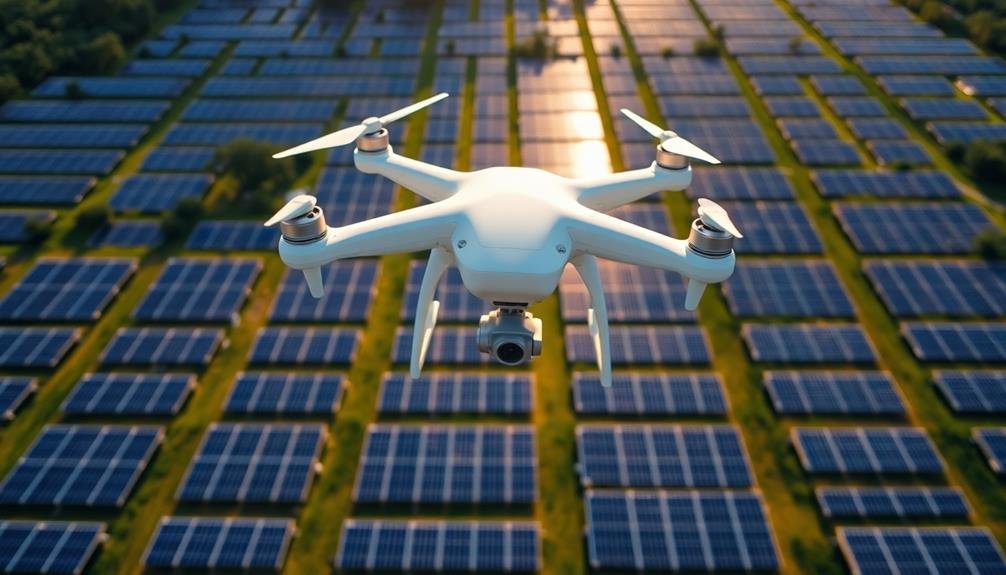
Drones have revolutionized solar farm inspections, making them faster, safer, and more efficient. When selecting a drone for your solar farm inspections, consider several key factors.
First, opt for a model with a high-resolution camera capable of capturing clear, detailed images of solar panels. Look for at least 12 megapixels and 4K video capabilities.
Battery life is significant, as you'll need a drone that can cover large areas without frequent recharging. Choose one with a flight time of at least 30 minutes.
GPS functionality is essential for precise navigation and mapping of the solar farm. Select a drone with obstacle avoidance technology to prevent collisions with structures or equipment.
Thermal imaging capabilities are invaluable for detecting hot spots and potential issues in solar panels. Invest in a drone with a built-in or attachable thermal camera.
Consider the drone's wind resistance, as solar farms are often in open areas prone to gusts. Look for models rated to operate in winds up to 20-25 mph.
Plan Your Flight Path
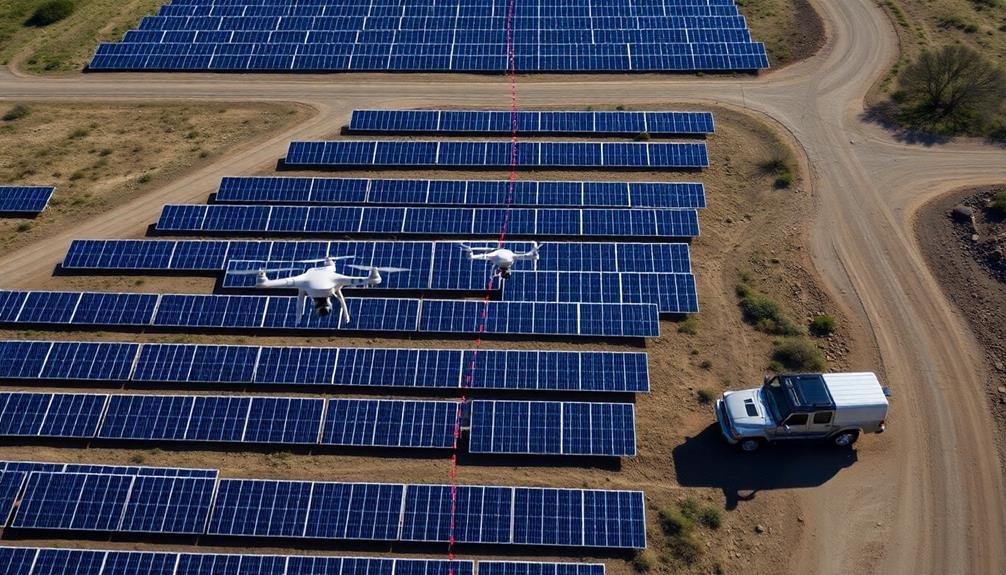
Careful planning is essential for effective solar farm inspections with drones. Before taking flight, map out your inspection route to cover the entire solar array efficiently. Consider the farm's layout, panel orientation, and any obstacles that might interfere with your flight path.
Start by dividing the solar farm into manageable sections. Plan to fly in a grid pattern, ensuring you capture overlapping images for thorough coverage. Set your drone's altitude to balance detail and coverage area. Lower altitudes provide higher resolution but require more passes, while higher altitudes cover more ground but may miss smaller defects.
Factor in the sun's position to avoid glare and shadows that could obscure panel defects. Early morning or late afternoon flights often yield the best results.
Don't forget to account for battery life and plan for multiple flights if needed. Use waypoint navigation features if your drone supports them. This allows for repeatable, precise flight paths and consistent data collection across inspections.
Remember to comply with local regulations and maintain visual line of sight throughout your flights.
Optimize Camera Settings
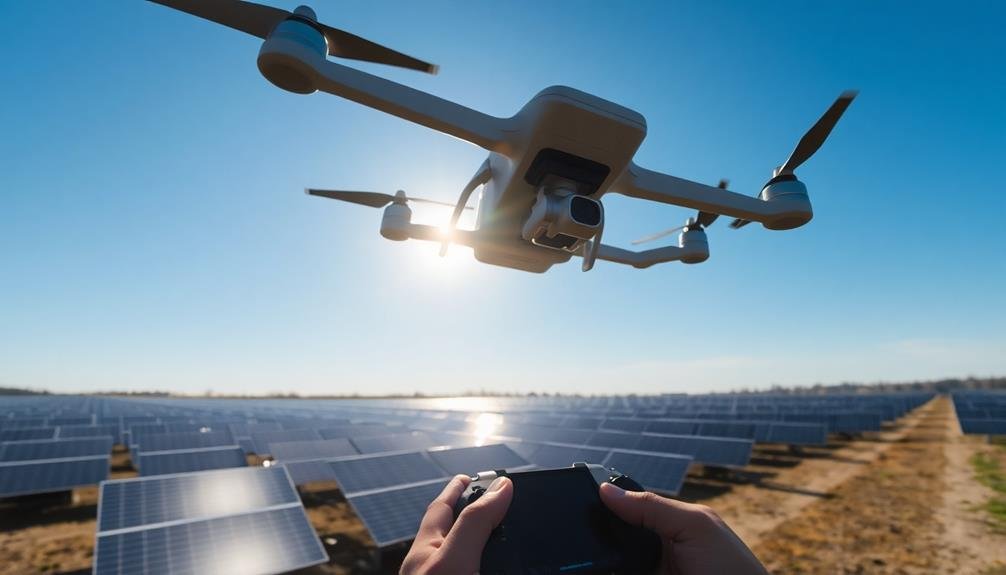
To capture high-quality images during solar farm inspections, you'll need to optimize your drone's camera settings.
Start by setting your camera to manual mode, giving you full control over exposure. Use a fast shutter speed, around 1/1000th of a second or faster, to prevent motion blur. Set your ISO as low as possible, ideally 100-400, to minimize noise in your images.
Choose an aperture between f/4 and f/8 for a good balance of depth of field and sharpness. Shoot in RAW format to preserve image data for post-processing. Enable any image stabilization features your drone camera offers to reduce vibration-induced blur.
For thermal imaging, set your camera to the appropriate temperature range for solar panels, typically 0-100°C. Use a color palette that clearly shows temperature variations, such as iron or rainbow. Adjust emissivity settings to account for the reflective surfaces of solar panels, usually around 0.85-0.95.
Consider using bracketing or HDR modes to capture a wider dynamic range, especially in challenging lighting conditions.
Use Thermal Imaging Technology
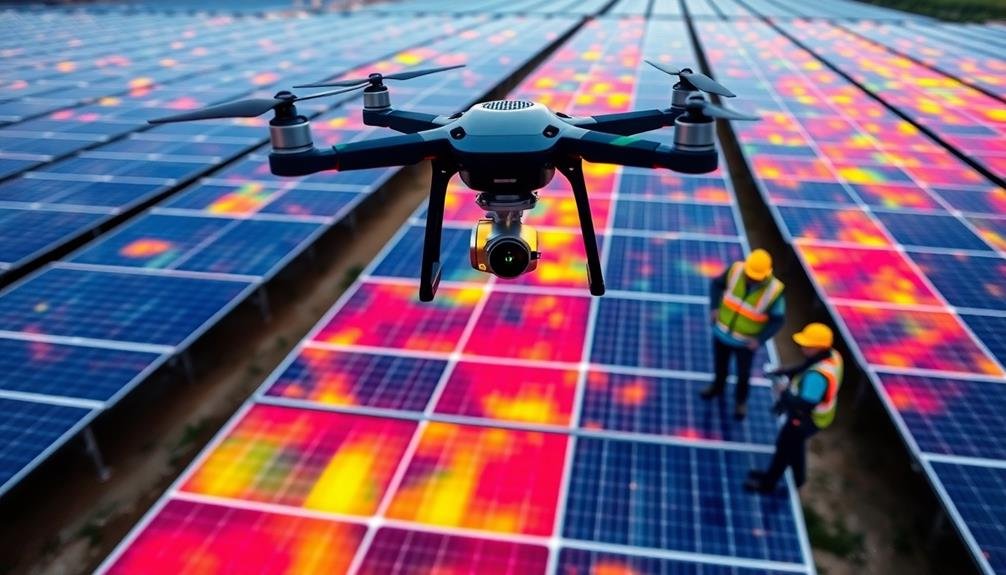
Thermal imaging technology is a powerful tool for your solar farm inspections.
You'll be able to identify hotspots and defects in panels, assess temperature variations across the array, and detect potential electrical issues before they escalate.
Identify Hotspots and Defects
Why is thermal imaging technology essential for solar farm inspections? It allows you to quickly identify hotspots and defects that aren't visible to the naked eye. By detecting temperature variations across solar panels, you'll spot potential issues before they lead to significant power losses or failures.
When using thermal imaging, look for these key indicators:
| Hotspot Type | Possible Cause |
|---|---|
| Isolated hot cells | Cracked or damaged cells |
| String of hot cells | Faulty bypass diodes |
| Entire panel hot | Wiring or connection issues |
| Cool spots | Delamination or moisture ingress |
| Uneven heating | Shading or soiling problems |
To effectively identify hotspots and defects, fly your drone in a grid pattern over the solar farm. Maintain a consistent altitude and speed for accurate comparisons. Capture thermal images during peak sunlight hours for the best results. Pay close attention to temperature differences between panels and within individual modules. Document any anomalies you find, including their location and severity. This data will help prioritize maintenance tasks and improve overall solar farm efficiency.
Assess Panel Temperature Variations
With thermal imaging technology in hand, you're ready to assess panel temperature variations across the solar farm. This vital step helps you identify underperforming panels and potential issues that may not be visible to the naked eye.
As you scan the array, look for any panels that appear markedly hotter or cooler than their neighbors. Healthy panels should exhibit a consistent temperature pattern. Panels that are noticeably warmer could indicate internal damage, poor connections, or shading issues. Cooler panels might suggest inactive cells or faulty wiring.
Pay close attention to temperature differences within individual panels. Hot spots or uneven heating patterns often point to cell degradation or bypass diode failures. These localized issues can greatly impact overall panel efficiency and may lead to further damage if left unchecked.
Don't forget to take into account environmental factors during your assessment. Shadows from nearby structures, bird droppings, or accumulated dust can all affect panel temperatures. Make note of these external influences to avoid misdiagnosing panel issues.
Detect Potential Electrical Issues
Your thermal imaging camera isn't just for spotting panel temperature variations; it's a powerful tool for detecting potential electrical issues throughout the solar farm. As you fly your drone over the array, pay close attention to any unusual heat signatures that could indicate electrical problems. Look for hotspots on inverters, combiner boxes, and wiring connections. These areas often heat up before a failure occurs, giving you a chance to address issues before they escalate.
When inspecting for electrical problems, focus on:
- Glowing junction boxes that appear much hotter than surrounding components
- Bright streaks or patterns along cables, suggesting current leakage or insulation breakdown
- Unusually warm inverters or transformers, indicating potential overloading or malfunction
Don't limit your inspection to just the panels. Check all electrical equipment, including switchgear and substations. By identifying these heat anomalies early, you can prevent costly breakdowns and maintain ideal energy production.
Remember, electrical issues can be subtle, so compare thermal images to baseline data whenever possible. This approach will help you spot even minor deviations that could signal developing problems.
Regular thermal inspections of your solar farm's electrical systems are essential for maintaining efficiency and preventing unexpected downtime.
Implement Automated Flight Patterns
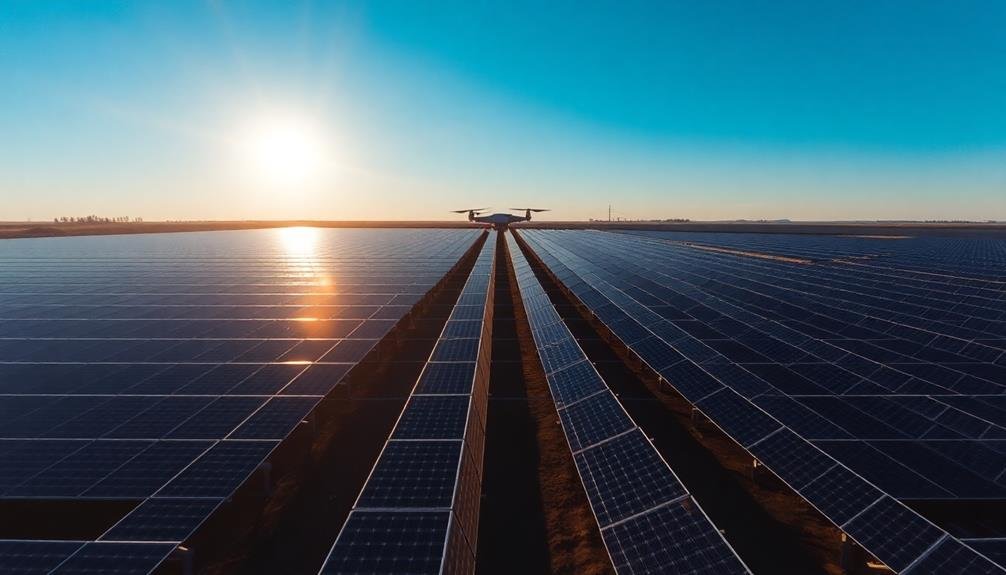
Maximize your solar farm inspection efficiency by implementing automated flight patterns for your drones.
You'll benefit from pre-programmed flight routes that guarantee consistent coverage and repeatable results.
Utilize grid-based inspection patterns to methodically scan each panel, while incorporating obstacle avoidance algorithms to navigate safely around structures and equipment.
Pre-Programmed Flight Routes
In light of the vast expanse of solar farms, implementing pre-programmed flight routes for drone inspections is essential. By setting up these routes in advance, you'll guarantee thorough coverage of the entire solar array while maximizing efficiency.
Pre-programmed paths allow for consistent, repeatable inspections, making it easier to compare data over time and identify potential issues.
When designing your flight routes, consider the layout of the solar panels and any obstacles or restricted areas. You'll want to create paths that cover each row of panels systematically, maintaining a consistent altitude and speed.
This approach helps capture high-quality imagery and thermal data for analysis.
To visualize effective pre-programmed flight routes, imagine:
- A grid-like pattern covering the entire solar farm
- Parallel lines following the rows of solar panels
- Strategically placed waypoints for precise navigation
Grid-Based Inspection Patterns
Grid-based inspection patterns form the backbone of efficient solar farm inspections. They allow you to systematically cover the entire solar array, ensuring no panel is missed. When implementing these patterns, divide your solar farm into sectors and create a grid overlay. This approach enables you to methodically inspect each section, maximizing coverage and minimizing redundancy.
You'll want to take into account the following factors when designing your grid-based pattern:
| Factor | Consideration | Impact |
|---|---|---|
| Panel Rows | Spacing | Flight path |
| Farm Size | Area coverage | Mission duration |
| Drone Altitude | Image resolution | Detail captured |
| Weather | Wind conditions | Flight stability |
| Time of Day | Shadows | Image quality |
Adjust your grid size based on the drone's camera capabilities and desired image overlap. Typically, you'll want 60-80% overlap between images for accurate stitching and analysis. Start with wider grids for initial scans, then tighten the pattern for areas requiring closer inspection. Remember to account for obstacles like inverters or transmission lines when planning your grid. By using grid-based patterns, you'll streamline your inspection process, reduce flight time, and capture thorough data for thorough solar farm analysis.
Obstacle Avoidance Algorithms
As drone technology advances, implementing obstacle avoidance algorithms has become essential for automated solar farm inspections. These algorithms enable your drones to navigate safely around obstacles, preventing collisions and ensuring smooth operations.
You'll find that modern drones come equipped with various sensors and cameras that feed real-time data into these algorithms, allowing them to detect and avoid potential hazards.
When selecting a drone for solar farm inspections, look for models with robust obstacle avoidance capabilities.
You'll want to evaluate systems that can:
- Detect obstacles from multiple angles, including above and below
- Adjust flight paths in real-time to maintain a safe distance from obstructions
- Recognize and avoid moving objects, such as birds or maintenance vehicles
Analyze Data in Real-Time
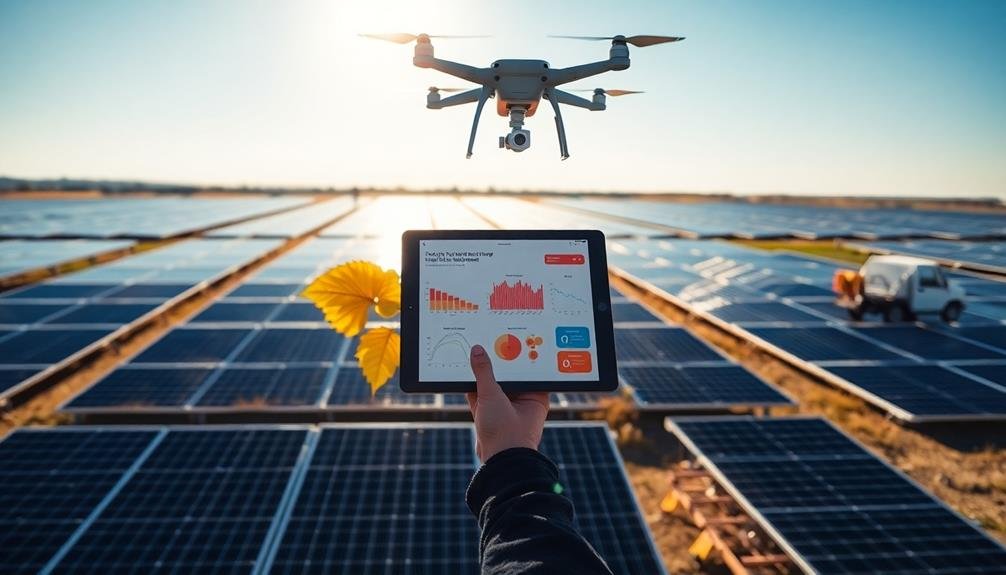
Real-time data analysis is essential for effective solar farm inspections. As you fly your drone over the solar panels, you'll want to process and interpret the information you're gathering immediately. This allows you to make quick decisions and adjust your inspection strategy on the fly.
Equip your drone with advanced sensors and software that can detect anomalies instantly. You'll be able to identify issues like hot spots, panel damage, or shading problems as they appear on your screen. This real-time feedback helps you focus on areas that need immediate attention, saving time and resources.
Consider using AI-powered algorithms to assist in your analysis. These tools can help you:
| Benefit | Description |
|---|---|
| Speed | Analyze data faster than human eyes |
| Accuracy | Detect subtle issues humans might miss |
| Pattern | Identify recurring problems across panels |
| Predict | Forecast potential failures before they occur |
Maintain Visual Line of Sight
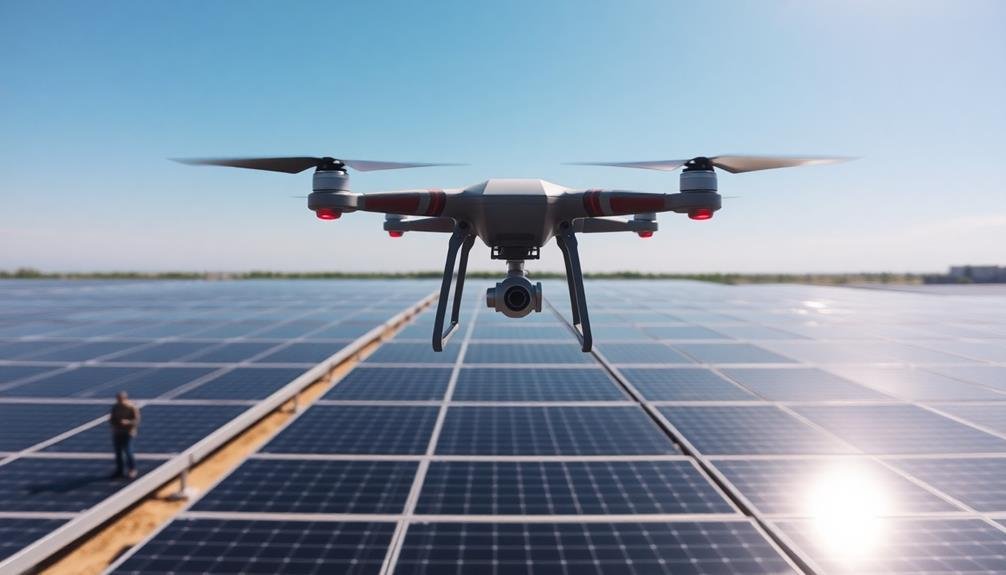
Maintaining visual line of sight is essential when conducting drone inspections of solar farms. You must always keep your drone within your view to guarantee safe operation and compliance with regulations. This means positioning yourself strategically on the ground to maximize your field of vision while flying.
Don't let obstacles like trees, buildings, or terrain features obstruct your view of the drone.
To maintain visual line of sight effectively:
- Scan the area before takeoff to identify potential blind spots
- Use a spotter to help monitor the drone's position and surroundings
- Wear polarized sunglasses to reduce glare and improve visibility
Remember that losing sight of your drone, even momentarily, can lead to accidents or legal issues. If you can't maintain visual contact, bring the drone back immediately.
Plan your flight path carefully, considering the layout of the solar farm and any potential obstructions. Break larger inspections into multiple flights if necessary to guarantee continuous visual contact.
Schedule Inspections Strategically
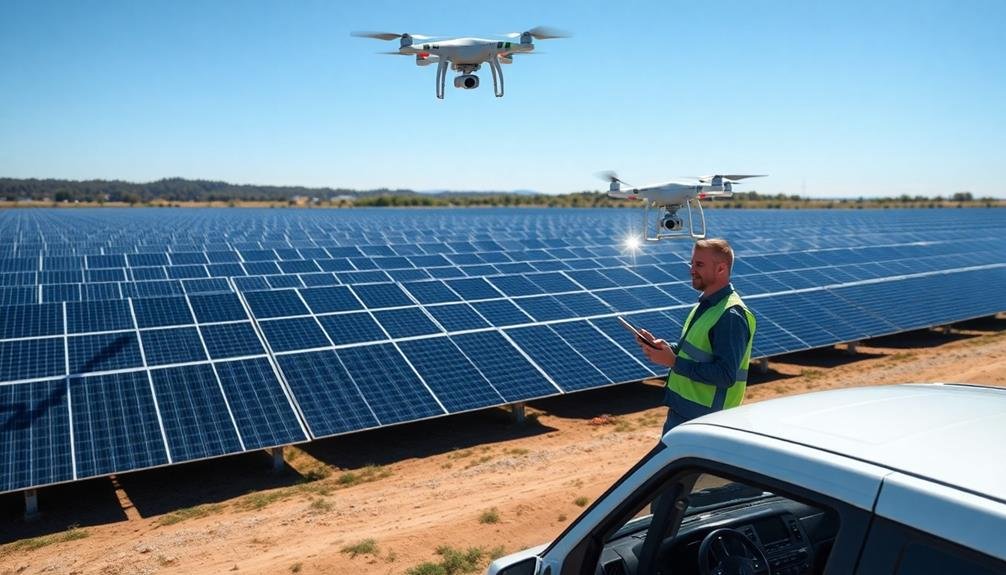
Scheduling inspections strategically is essential to maximizing the efficiency and effectiveness of your solar farm drone surveys. Consider the time of day, weather conditions, and seasonal factors when planning your inspections. Early morning or late afternoon flights often provide the best lighting conditions for capturing clear images and thermal data. Avoid midday inspections when shadows are minimal, as they can mask potential issues.
You'll want to schedule inspections during periods of peak solar intensity to identify performance issues more easily. However, be mindful of extreme temperatures that might affect drone performance. Plan your surveys during clear, calm weather to guarantee ideal flight conditions and image quality.
Seasonal considerations are vital too. Schedule thorough inspections after winter to detect any cold-weather damage, and before summer to prepare for peak production periods.
Coordinate your drone inspections with regular maintenance schedules to minimize disruptions to solar farm operations. By aligning these activities, you'll streamline the overall maintenance process and reduce downtime.
Don't forget to factor in battery life and drone range when planning multiple inspection flights. Efficient route planning will help you cover more ground in fewer flights, saving time and resources.
Utilize AI for Defect Detection
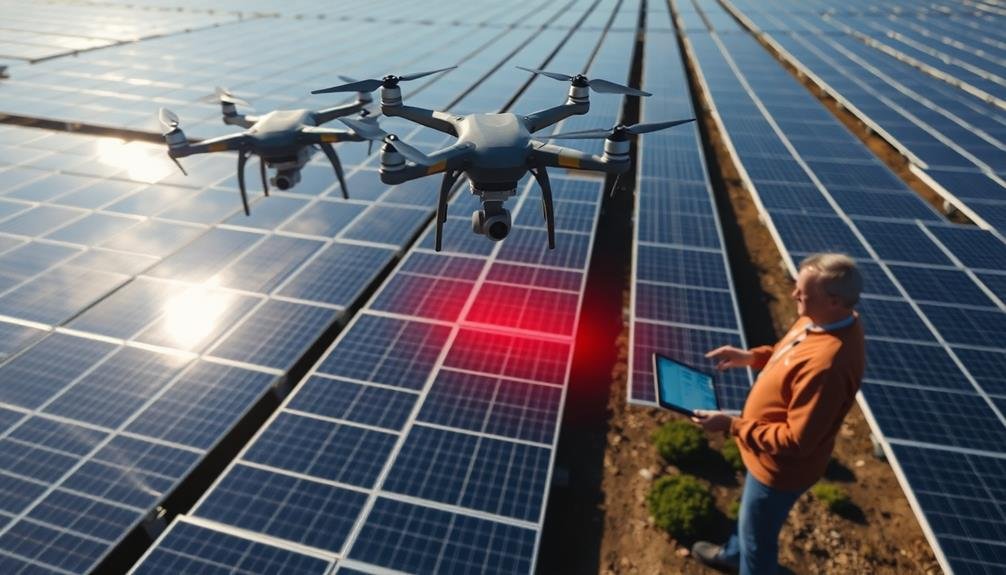
AI-powered image analysis is revolutionizing solar farm inspections.
You'll find machine learning algorithms can quickly process vast amounts of visual data from your panels.
These advanced systems offer automated fault identification, allowing you to spot issues faster and more accurately than ever before.
Ai-Powered Image Analysis
Many solar farm inspections are now leveraging AI-powered image analysis for defect detection. This technology allows you to process large volumes of aerial imagery quickly and accurately, identifying potential issues that might be missed by human inspectors.
You'll find that AI algorithms can detect a wide range of defects, including hot spots, cracks, soiling, and vegetation encroachment.
To implement AI-powered image analysis in your solar farm inspections, you'll need to:
- Collect high-quality aerial imagery using drones or satellites
- Use specialized software to process and analyze the images
- Train the AI model on your specific solar panel types and common defects
You'll benefit from faster inspection times, reduced labor costs, and improved accuracy in defect detection. The AI system can prioritize areas of concern, allowing you to focus your maintenance efforts where they're needed most.
As you continue to use AI-powered analysis, you'll build an all-encompassing database of your solar farm's performance over time. This data will help you predict future maintenance needs and optimize your inspection schedules, ultimately improving the overall efficiency and longevity of your solar installation.
Machine Learning Algorithms
With machine learning algorithms, you can take your AI-powered solar farm inspections to the next level. These advanced techniques enable your system to learn from vast datasets, improving accuracy and efficiency over time. You'll be able to detect defects, predict maintenance needs, and optimize performance with greater precision.
Implement various machine learning models to address different aspects of solar farm inspection:
| Algorithm Type | Application | Benefits |
|---|---|---|
| Convolutional Neural Networks | Image classification | Accurately identify panel defects |
| Random Forests | Anomaly detection | Spot unusual patterns in performance data |
| Support Vector Machines | Predictive maintenance | Forecast equipment failures |
| Recurrent Neural Networks | Time series analysis | Analyze long-term performance trends |
| Reinforcement Learning | Optimization | Improve inspection drone flight paths |
Automated Fault Identification
By leveraging automated fault identification systems, you'll revolutionize your solar farm inspections. These AI-powered tools analyze thermal and visual data from drone flights, quickly identifying potential issues across vast arrays of solar panels.
You'll save time and resources by pinpointing exact locations of faults, allowing maintenance teams to address problems efficiently.
Automated systems can detect a wide range of defects, including:
- Hot spots indicating cell degradation
- Bypass diode failures causing string outages
- Microcracks and delamination in panel surfaces
With this technology, you'll catch problems early, preventing small issues from escalating into costly failures.
You'll also benefit from consistent, objective assessments that aren't subject to human error or fatigue.
Implement automated fault identification by integrating it with your existing inspection workflows. Train your staff to interpret AI-generated reports and verify findings.
Regularly update your AI models with new data to improve accuracy and adapt to emerging fault types.
Ensure Proper Data Storage
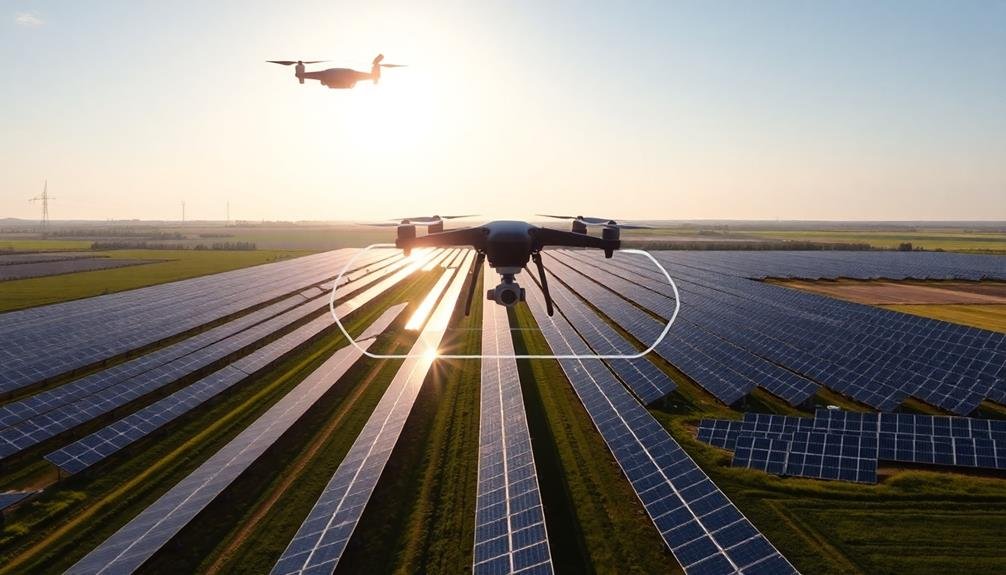
Proper data storage is a critical aspect of solar farm inspections. You'll need to implement a robust system to securely store and manage the vast amount of data collected during drone surveys. Start by establishing a centralized database that can handle large files, including high-resolution images and thermal data. Ascertain this system is scalable to accommodate your growing data needs over time.
Use cloud-based storage solutions to enable easy access and collaboration among team members. Implement strict access controls and encryption to protect sensitive information. Don't forget to create a regular backup schedule to prevent data loss in case of system failures.
Organize your data logically, using a consistent naming convention for files and folders. This will make it easier to retrieve specific information when needed. Consider using metadata tags to categorize and search through your data efficiently.
Implement a data retention policy that complies with industry regulations and your company's needs. Regularly archive or delete outdated information to keep your storage system lean and efficient.
Frequently Asked Questions
How Often Should Solar Farm Inspections Be Conducted?
You should conduct solar farm inspections at least annually, but it's best to do them quarterly. If you're in a harsh climate or experiencing performance issues, you'll want to inspect more frequently, perhaps monthly or after severe weather events.
What Certifications Are Required for Drone Operators Inspecting Solar Farms?
You'll need a Part 107 Remote Pilot Certificate from the FAA to operate drones commercially for solar farm inspections. It's also beneficial to have thermal imaging certifications and solar-specific training to enhance your inspection skills.
Can Drones Inspect Solar Farms at Night?
Yes, you can use drones to inspect solar farms at night. You'll need specialized thermal imaging cameras to detect heat anomalies. Night inspections can reveal issues that aren't visible during the day, like hot spots or faulty connections.
How Do Weather Conditions Affect Drone Inspections of Solar Farms?
You'll find weather greatly impacts drone inspections of solar farms. Wind can disrupt flight stability, rain affects visibility, and extreme temperatures may limit battery life. Cloud cover can also interfere with thermal imaging accuracy. Always check conditions before flying.
What Are the Legal Considerations for Flying Drones Over Solar Farms?
You'll need to obtain proper licenses and permissions before flying drones over solar farms. Check local regulations, respect privacy laws, and secure landowner consent. Don't forget to follow FAA guidelines for commercial drone operations.
In Summary
You've now got the tools to revolutionize your solar farm inspections. By implementing these tips, you'll save time, increase accuracy, and boost overall efficiency. Remember, it's not just about flying a drone; it's about strategic planning, using the right technology, and leveraging AI. Keep honing your skills and stay up-to-date with the latest advancements. With practice, you'll become a pro at identifying issues and optimizing solar farm performance from above.

As educators and advocates for responsible drone use, we’re committed to sharing our knowledge and expertise with aspiring aerial photographers.
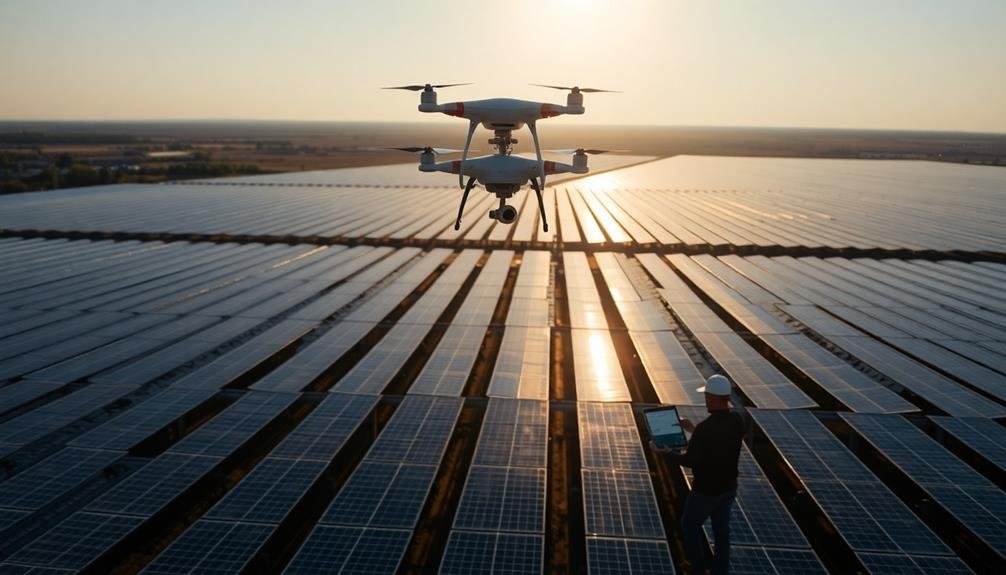



Leave a Reply